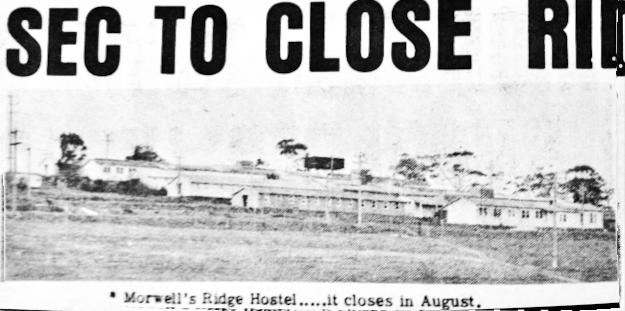Looking Back - April 2024
By Leo Billington
Do you remember parts of Morwell’s history?
Around 1877, Roger O’Flaherty arrived in what was then a small hamlet, to select land. He figured what was then named Morwell Bridge would not suit his entrepreneurial ambitions and he moved eastwards to assess what land was available resulting from two surveys - in October 1878 and October 1882. It was deemed that Morwell would become a new village to by-pass the Morwell Bridge village. These two surveys added another six blocks to an initial three blocks. This new village, and its allotments, was bordered by Hazelwood Road, Commercial Road, Chapel Street and McLean Street.
The first sale of these allotments is recorded to have taken place on January 14, 1879. Roger O’Flaherty was one buyer. Roger became well known as a cattle dealer. This was his listed occupation beside names of his three children - Michael, Julia and Edward - enrolled at the Morwell State School (to become known as Commercial Road State School). He lived on the corner of Ann and Tarwin Streets although his search for extra allotments took him to Traralgon and subsequently to Western Australia.
Roger’s quest for more land, known then as Maryvale, east of Morwell was approved by granting of a licence on Monday February 18, 1878. Thereafter, he obtained a larger allotment to the south of town adjacent to Robert Tolmie. Early land maps show his selection then extended east of the town to Tramway Road.
The 1881 Census recorded Morwell as having 28 dwellings. Over the next three years over 134 other buildings were added and Commercial Road became the business centre of the town
The area now being excavated, across the railway from Mid Valley, was Roger’s eastern boundary. How he managed his extensive acreage is one of history’s intriguing questions. It is documented that some of Roger’s land was re-possessed by the State government so a “property” could be established near the railway station.
Roger, then aged 56 years, was killed in a fatal accident at the North Fremantle Railway Station on Saturday morning, May 8, 1897. One wonders why a Morwell street was never named in his honour.
More about Roger in the next Churchill & District News.

The State Electricity Commission of Victoria, SECV in the Morwell Advertiser Thursday February 17, 1949 invited tenders “for the erection of Camp Buildings at Ridge Hostel Morwell.” In the same newspaper, the SECV invited tenders for “the erection of a brick kitchen.” Cockram Constructions Pty Ltd won the tender.
In May 1950, advertisements also sought carpenters and plasterers. Melbourne based contractor, Cockram Constructions Pty Ltd - founded in 1861 - required carpenters and Picton Hopkins & Sons - founded in 1857 - wanted plasterers.
Cost of construction was £17,846, officially approved by the Victorian Governor in Council on June 19, 1951. In July, 1952, loan money for SECV works was cut from £52 million to £44 million, resulting in a reduction in worker numbers. Dismissals were certain.
While Cockram Constructions tendered at £17,846, it was reported in The Argus, May 17, 1949 that “a hostel to be built at Morwell to house 1,000 will be completed by November, the SECV announced.” It seems a budget of £144,700 was mentioned. Accommodation was intended for workers at the Morwell briquette and brown coal project.

While all this was going on, progress at Morwell’s briquette and brown coal project was spasmodic. The Morwell Council Chambers on Monday April 23,1951, debated social issues including permanent works, seasonal workers were not wanted, there was assurance Morwell would show loyalty in “helping to assimilate the migrants’, a pending shortage of labour for already established Morwell businesses, who would train unskilled labour, and, anyway, “Hostels were only temporary structures.”
Nonetheless, it was “go go go” and Morwell wondered what was really happening. An unofficial Post Office was established by the S.E.C.V. Ridge workers’ hostel on May 1, 1951. However, the name Morwell Heights was chosen in preference to Morwell Ridge as it was considered that reference to the word Ridge might cause some historical confusion. Mr. R. Jones, a former Post Master at Boolarra was appointed officer-in-charge.
Caution regarding going over budget remained a concern. Optimism suddenly took over in about June 1954 - it was announced “a large modern hostel built for single men was to re-open.”
At last, decisions were being made regarding accommodation for single men.
Fast forward to the decade of mounting SECV debt, privatisation of the SECV and a climate of Voluntary Departure Packages (VDP’s), the Morwell Ridge Hostel/Morwell Heights accommodation facility was subsequently shut down.

In brief, and readers may recall, Howes and Medew Transport Pty Ltd was a key Morwell based business. The business was acquired by Mayne Nickless in 1972. Mayne Nickless also bought East Coast Transport in 1969 and Intermodal in the early 1980’s. The accompanying aerial photograph gives us a reminder of their transport yard in Latrobe Road, now the home for Bensons Hardware.
Finally, let us pay our respects to the infamous Cherry Ripe.

This popular chocolate bar was introduced to Australians in 1924 - 100 years ago. With coconut, and cherries encased in rich Old Gold dark chocolate, it has remained a top seller to date. Let us celebrate by eating Cherry Ripes!


